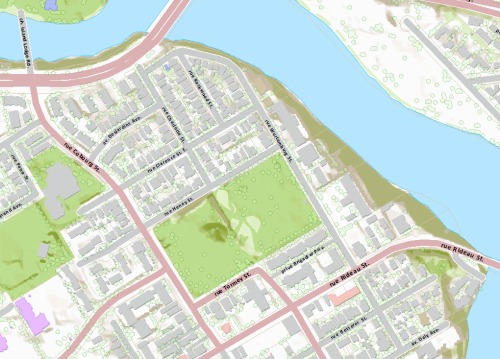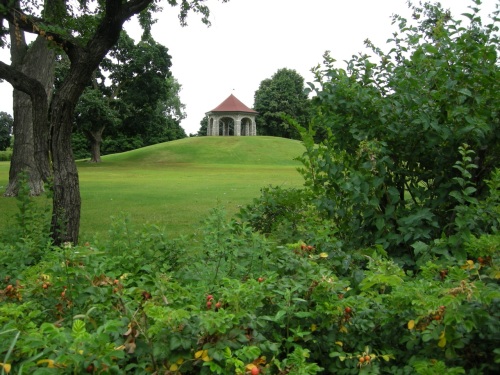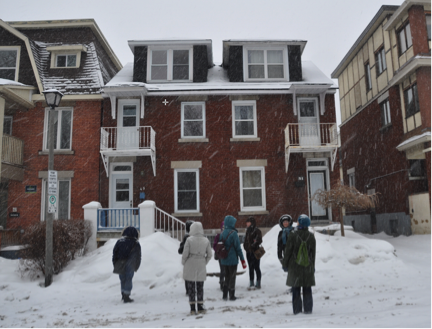On August 13, 2014 the Lowertown Community Association organized a celebration of the 100th anniversary of Macdonald Gardens Park. This park, and the neighbourhood that surrounds it, are the subject of this website, a study in community heritage.
The Ottawa neighbourhood known as Macdonald Gardens lies in the eastern-most corner of ‘Lowertown East’, tucked away north of Rideau St., west and south of the Rideau River, and east of Cobourg Street. At what is more or less its geographical centre is the Macdonald Gardens park: eight acres of grass, trees, and winding paths. It is this park that will spring to the minds of most who hear the name, partially because of its iconic summer house on a hill and partially because of its history as one of Ottawa’s earliest cemeteries. Yet the neighbourhood surrounding this park is also one of Ottawa’s oldest, and is equally worthy of study and commemoration.
The area’s housing and residents are a complex, diverse mix: it is possible, through a study of Macdonald Gardens’ built heritage, to see a microcosm of Ottawa’s changing cultural and urban planning landscape over the course of the 20th century. An integral part of that built and cultural heritage is the institutional presence that dominated this area in the early 20th century, whose hospitals and embassies shaped, and in some cases, continue to be part of the social makeup of the neighbourhood. Although urban renewal ravaged much of Lowertown East in the late 1960s, this section of the larger plan was left relatively less scathed, resulting in a well-preserved built landscape that can tell us much about the value of what was otherwise lost as the city shifted into a period of much denser urban growth. This park and the built heritage around it tell a story of Ottawa’s many attempts to beautify itself, to be seen as a national capital, and to attempt to meet the housing needs of its residents.
Initiated at the request of community members, this report was completed by students in CDNS 5402, a graduate seminar in Heritage Conservation at Carleton University’s School of Canadian Studies between January and August 2014. It explores the layers of historic values that the neighbourhood of Macdonald Gardens possesses, including providing a draft Statement of Significance for review by the community. Recognizing that there is still yet much more work to be done, this report also provides recommendation for further research and action. It is our hope that this research will be useful in helping the Macdonald Gardens community to further understand the area’s history, and possible heritage values, and in identifying next steps the community might take to reinforce its capacity to survive future urban development.
Student team: Margaret Caron-Vuotari, Caitlin Charbonneau, Victoria Ellis, Stephanie Elliott, Sachi Hirono, Heather Leroux and Emily Webster-Mason
Report Editors: Victoria Ellis, MA student, and Professor Susan Ross, Heritage Conservation Programme, Carleton University
We would also like to acknowledge the help and input of Nancy Miller-Chenier of the Lowertown Community Association (LCA), whose knowledge and direction were essential to this project.
As part of this report, we have drafted an initial Statement of Significance (SOS) to attempt to summarize the value of the Macdonald Gardens neighbourhood.
We would like to emphasize that this draft SOS is written entirely by the report editors without extensive community engagement. The next steps for this report will include discussion with community members in order to validate the values expressed here. Please refer to section 6.3 in our report for more information.
To download this draft Statement of Significance, CLICK HERE.




Thanks for this. It woke up my past experience with Macdonald Gardens. In the early1950’s I was a student at York Street School, and lived on Tremblay Road. The main bus terminal was at Rideau and Charlotte Streets, so the park was a peripheral part many days. As a typical kid, I was only aware of a nice big green space with pretty houses.
When I changed schools and neighbourhoods I was away from the park for many years. Returning to the park – and the neighbourhood I have always felt disoriented – trying to overlay my childhood memories of streetscapes on to the reality of the present-day park. I am not very good with spacial issues, so It was helpful to read your report. which laid out the street changes etc. Just the facts – but I found it very useful.
I wonder about the people who lived in the area during “urban renewal” – how disoriented they must feel if they live in the “new Lowertown” with the old neighbourhoods etched into their childhood memories.